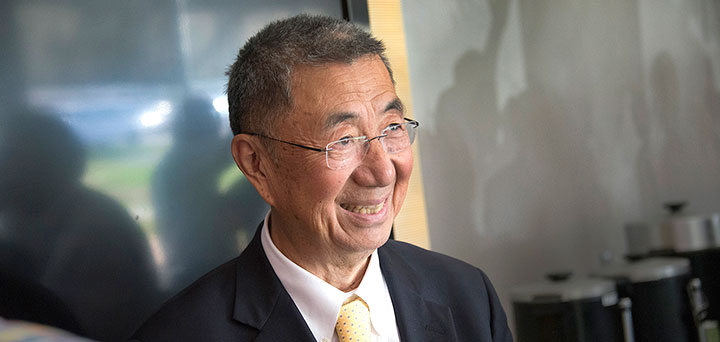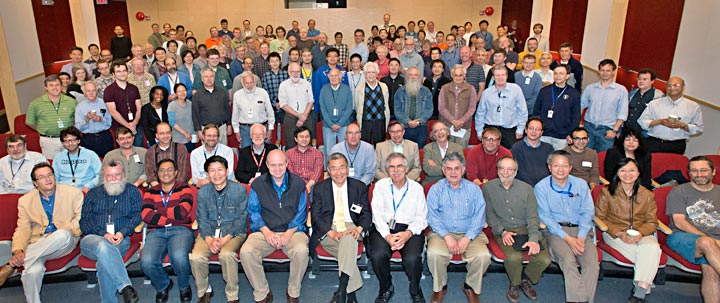Nobel Laureate Samuel Ting Returns to Brookhaven Lab
Presents Results From Experiment Aboard International Space Station During Physics Colloquium
May 17, 2013

Samuel Ting during his recent appearance at Brookhaven Lab.
Nearly every seat was taken in the Physics Seminar Room at Brookhaven Lab as Nobel Laureate Samuel Ting returned to Brookhaven from the Massachusetts Institute of Technology to speak on May 7. Ting shared the 1976 Nobel Prize for Physics for discovering a new particle, now called "J/psi," confirming existence of the charmed quark using Brookhaven Lab's Alternating Gradient Synchrotron. While on site last week, Ting spoke at a Physics Colloquium to present early findings from the Alpha Magnetic Spectrometer (AMS), a multipurpose particle physics detector aboard the International Space Station.
Ting's presentation was of great interest to researchers at Brookhaven Lab, who are seeking to help answer questions about physics of the universe and the nature of matter in the world around us. The AMS experiment was installed on the exterior of the International Space Station in May 2011. The particle physics detector was built by an international collaboration of 56 institutions from 16 countries with support from the U.S. Department of Energy. Researchers, including Ting, are using the detector to perform precision measurements of cosmic rays in space, where the highest energy particles are produced. This data is indispensable as the researchers study the universe and its origin by searching for antimatter that can help elucidate both why there is more matter than antimatter in the universe as well as the nature of the dark matter that is hypothesized to account for a significant portion of the total mass in the universe. Ting reported on studies of positrons, which are sensitive to the annihilation of dark matter particles and can provide a measure of these mysterious particles' mass.
"Dr. Ting shared a seminal moment in the history of Brookhaven Lab and today, our scientists are also working to answer the question of why there is more matter than antimatter in the universe," said Associate Chair of Brookhaven's Physics Department Laurence Littenberg, who will succeed present Physics Chair Thomas Ludlam on July 1. "The AMS experiment is a remarkable project, Samuel Ting is a remarkable scientist. We were excited to hear his high-quality results and honored that he presented them at the Lab."
 enlarge
enlarge
(Front row, sixth from left) Samuel Ting of MIT—who shared the 1976 Nobel Prize for Physics for discovering a new particle, now called "J/psi," confirming existence of the charmed quark using Brookhaven Lab's Alternating Gradient Synchrotron—returned to the Lab on May 7 to present results from a particle physics detector aboard the International Space Station.
"The results Dr. Ting presented from the AMS experiment are tantalizing but more data expected in the next few years will be necessary in order to determine whether there is evidence of dark matter," said Physics Department Deputy Chair Howard Gordon. "Meanwhile, Brookhaven continues in a lead role for the ATLAS collaboration at the Large Hadron Collider (LHC) in Europe. Plans are under way to operate the LHC in 2015 at energy levels where we could also address mysteries of dark matter."
Not all Physics Colloquia feature Nobel Prize winning speakers such as Ting, but each speaker presents topic of great interest in atomic physics, astrophysics, particle and nuclear physics, as well as condensed matter physics and material science. These talks are held in the Physics Seminar Room (Bldg. 510), typically on Tuesdays. Future talks will be listed on the Lab's calendar of upcoming events, and all are invited.
2013-3958 | INT/EXT | Newsroom









